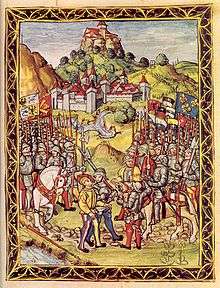Treason of Novara

The so-called Treason of Novara (Verrat von Novara) was an incident which took place in 1500 in the context of the involvement of the Old Swiss Confederacy in the Italian Wars.
It was an early instance of Swiss mercenaries finding themselves on both sides of a conflict: Louis XII of France had conquered the Duchy of Milan in 1499 with the help of Swiss mercenaries. In the spring of 1500, Ludovico Sforza in his turn hired Swiss mercenaries in his bid to re-conquer the duchy. The two hosts confronted one another at Novara. About 6,000 Swiss under the command of Sforza defended the city, while about 10,000 Swiss under the command of Louis laid siege to it. The Swiss diet called for negotiations between the two sides in an attempt to prevent the worst case of the Swiss on both sides being forced to slaughter one another, "brothers against brothers and fathers against sons". Louis agreed to a conditional surrender which would grant free passage to the Swiss abandoning the city, but only under the condition that Sforza would be surrendered. However, the Swiss on Sforza's side, under an oath of loyalty to their employer, decided to dress Sforza as a Swiss and smuggle him out of town.
On 10 April, the Swiss garrison was leaving Novara, passing a cordon formed by the Swiss on the French side. French officers were posted to oversee their exit. As the disguised Sforza passed the cordon, one mercenary Hans (or Rudi) Turman of Uri made signs giving away Sforza's identity. The duke was apprehended by the French and died eight years later, incarcerated in the castle of Loches.
The French rewarded Turmann for his treason with 200 gold crowns (corresponding to five years' salary of a mercenary). He escaped to France, but after three years (or, according to some sources, after one year) he returned home to Uri. He was immediately arrested for treason, and on the following day he was executed by decapitation.
References
- Hans Stadler: Battles of Novara in German, French and Italian in the online Historical Dictionary of Switzerland.
- B. Kindt, Die Katastrophe Ludovico Moros in Novara im April 1500 (1890).